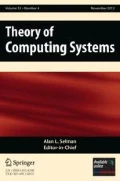Abstract.
Maximum G Edge-Packing (EPack G ) is the problem of finding the maximum number of edge-disjoint isomorphic copies of a fixed guest graph G in a host graph H . This paper investigates the computational complexity of edge-packing for planar guests and planar hosts. Edge-packing is solvable in polynomial time when both G and H are trees. Edge-packing is solvable in linear time when H is outerplanar and G is either a 3-cycle or a k -star (a graph isomorphic to K 1,k ). Edge-packing is NP-complete when H is planar and G is either a cycle or a tree with \(\geq 3\) edges. A strategy for developing polynomial-time approximation algorithms for planar hosts is exemplified by a linear-time approximation algorithm that finds a k -star edge-packing of size at least half the optimal.
Similar content being viewed by others
Author information
Authors and Affiliations
Additional information
Received May 1995, and in revised form November 1995, and in final form December 1997.
Rights and permissions
About this article
Cite this article
Heath, L., Vergara, J. Edge-Packing in Planar Graphs. Theory Comput. Systems 31, 629–662 (1998). https://doi.org/10.1007/s002240000107
Issue Date:
DOI: https://doi.org/10.1007/s002240000107




